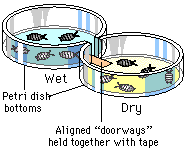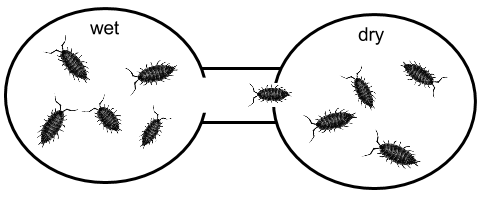Isopod Behavior, or The RollyPolly Lab
Objectives:
- Observe various aspects of a terrestrial isopod
- Conduct experiments examining the responses of isopods to various environmental factors
- Design and conduct an investigation of animal behavior
Isopod Handling and Rearing
Raise isopods in a clear shoebox or similar, the bottom should be covered with soil or sand and kept moist (use a mister). An old piece of bark, and leaf litter covering the soil. Isopods can be fed carrots, raw pototoes or apples (alternately fish flakes can be used as food). Moldy food or soil should be removed. Females can carry up to 200 eggs in a brood pouch underneath her abdomen and will remain in the pouch for about three weeks - they look the same as adults, only smaller.
Larger isopods can be handled and observed easily with your hand, by picking them up with your fingers or gently scooping them up with a spoon. They are fast walkers and can withstand short drops. Immature isopods are more fragile than adults.
**Isopods are also called sowbugs and pillbugs.
Background Information
Terrestrial ispods are land dwelling crustaceans, commonly known as sowbugs or pillbugs (or rollypollys). They are related to lobsters, crabs, and shrimp and terrestrial isopods breath with gills. While they look similar, sow bugs are different from pill bugs. Pill bugs will curl into a ball when threatened whereas sow bugs will attempt to flee. Since your isopods are caught from the wild, make sure you are using the same type for your experiments.
Ethology is the study of animal behavior. Many behaviors involve movement of the animal within its environment. In this exercise, you will investigate some innate (instincts) behaviors of isopods.
Orientation is a process by which animals position themselves with respect to spatial features of their environments. Taxis involves the turning of an animal's body relative to a stimulus - either toward or away. Kinesis is a random movement of an animal in relation to a stimulus, like cockroaches scattering when the light is turned on.
Consider the following example: A researcher places a dead rotting mouse in the center of a test area and adds a carrion beetle (an insect that eats dead animals) somewhere on the surface. The beetle crawls forward for three seconds, turns and crawls in a different direction for three seconds, and so on. The researcher concludes that the beeetle is moving randomly in relation to the dead mouse.
Continued observation reveals that the beetle crawls faster (and covers more ground) when it happens to turn in the direction of the dead mouse. In addition, the beetle crawls more slowly (and covers less ground) when it happens to crawl away from the mouse. In this way, the beetle's random movements will eventually bring it to the dead mouse. It is important to take in details such as time spent crawling in one direction or another when observing the movements of the animals.

Isopod Observations
In the first part of this exercise, you will observe pillbugs and record what you see.
Analysis (include in lab report) - some answers you may need to investigate on your own
- How do the pillbugs seem to sense their environment?
- Are they all the same species?
- Can you tell the difference in males and females?
- How many eyes do they have? How many legs?
- Do they exhibit dominance behaviors?
- How do they respire?
- What are some stimuli they seem to respond to?
The Behavior Chamber
For the experiments you design, you will need to create a chamber to test the isopods reactions. Each basic chamber will consist of two sides, each side having a different environment, plus a tube that connects the chambers so that the isopods can move from one place to the other.
Materials - plastic cups, straws, plastic bowls (or other things your teacher might provide for you). The same chamber can be used for multiple experiments. Alternately, behavior chambers can be purchased.
Alternatively, you may have Choice Chambers available.
Example:

Part A - Orientation of Isopods in Response to Moisture
Procedure: Set up your behavior chamber so that you have one side moist and one side dry (using paper towels). Transfer 5 isopods to each side of the chamber (total of 10). Count and record the number of animals on each side of the chamber every 30 seconds for ten minutes, using a table like the one below.
You will need to include this data in your lab report!
| Time | # in Wet | # in Dry | Other Notes |
| 0:00 | |||
| 0:30 | |||
| 1:00 | |||
| 1:30 |
Part B - Student Designed Experiment
Select TWO of the following factors to investigate and design an experiment to test it. (Use the procedure above as a guideline.) You may also propose your own test, check with your instructor. Consider that in science, testing variables separately provides the most useful evidence. You will also need to include data on these experiment in your lab report, similar to the chart above.
| Factor | Possible Materials |
| Temperature | Cold pack, warm pack, ice, warm water |
| Light | Lamps, flashlights, dark construction paper, aluminum foil |
| pH | HCL, NaOH, vinegar, baking soda |
| Substrate (surface) | Soil, sand, bark, cedar, gravel |
| Odor | Ammonia, perfume, lemon juice |
| Food | Potato, fish flakes |
| Organisms | Crickets, earthworms, plants |
Lab Report
1. Background and purpose of the experiment (check the "objectives" at the beginning of this handout)
2. Isopod Observations (see questions in that section)
3. Orientation in Reponse to Moisture (include data table)
4. Student Designed Experiment (Detailed description of your experiment, your
hypothesis, data and conclusions)
5. Suggest reasons for the observed behavior, consider it from an evolutionary point of view (how is this behavior an advantage)
6. Suggest ways the experiment could have been improved with more time or resources
